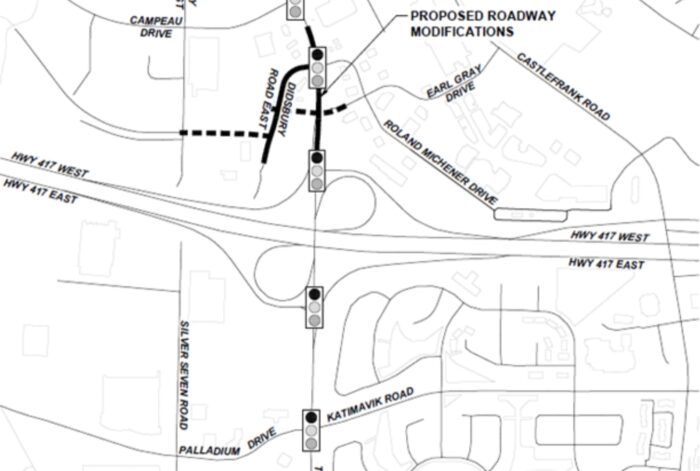This project comes to the City’s Finance and Corporate Services Committee on March 5. We strongly encourage you to contact your councillor about it.
An old roadway design is seeing new light in Kanata. Despite being delayed for almost 30 years, an underpass under Terry Fox Drive at Earl Grey Drive is proposed to be built this year. The funding is secured and construction is soon to be underway. Although it is a very large-budget project – one of the largest on the books for this year – there was very little information shared that would justify the project’s cost. We think the public consultation process is a very important step in the modification of our public infrastructure, so we took it upon ourselves to shed some light into the project. This blog post will discuss the background of the project, the budget, the proposed design, and finally our view on it.
Background
In June 2023 Bike Ottawa was made aware that the City of Ottawa posted a notice about constructing an underpass under Terry Fox Drive at the intersection of Earl Grey Drive, just north of Highway 417. As seen below, it is the intersection adjacent to the Kanata Centrum Shopping Centre.
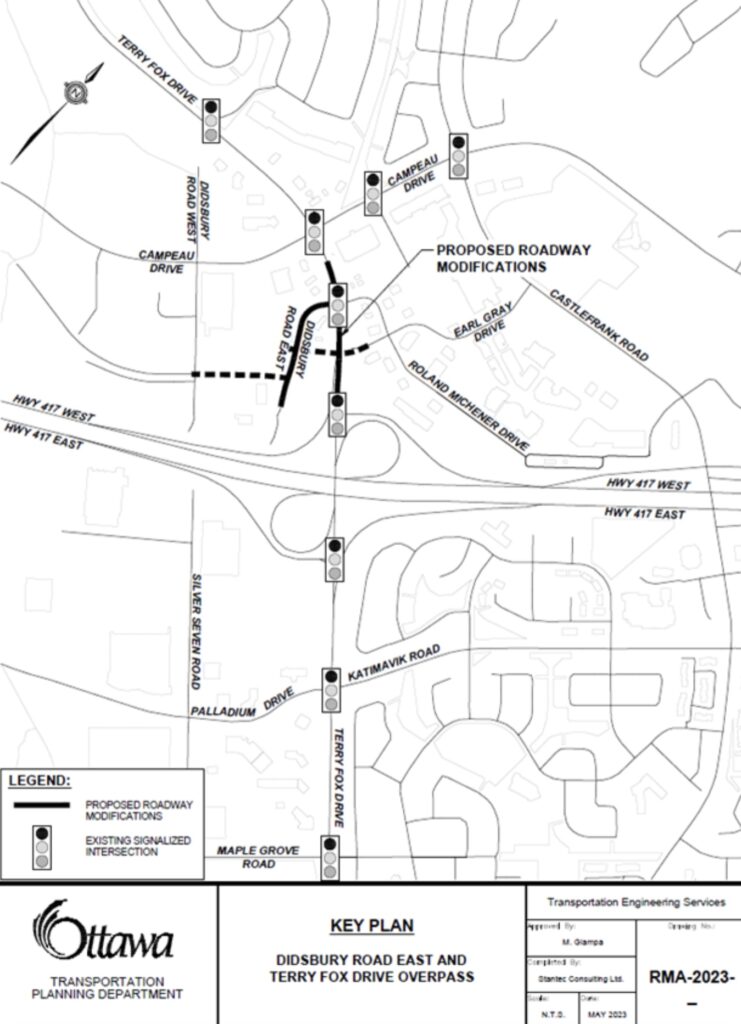
The notice on the City of Ottawa website did not include a link to a project web page or any designs, but simply described a modification of the roadway was to take place. It is unclear how long the notice was on the city website, but unfortunately we can no longer access it.
A review into the city’s archives reveals that while the implementation of the plan is intended for the coming year, the idea is a very old one – one that even predates amalgamation in 2001! We attempted to find the original plans, but were unsuccessful. The earliest excerpt we found in the city records that mentions this project is from the Terry Fox Environmental Study Report from 2000 that reads:
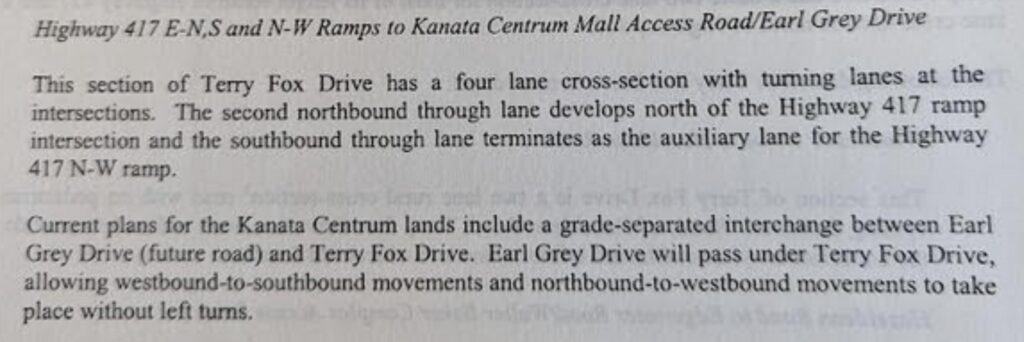
Recent conversations with city staff revealed that this extension was a condition of the 1995 Plan of Subdivision for the Kanata Centrum development. Obviously, this project has been on the city’s to-do list for quite some time!
Design & Purpose
The proposed design is pictured below. From what we gathered, the plan proposes the following main changes:
- To have Earl Grey Drive pass under Terry Fox Drive with a newly constructed underpass. No cycling facilities are planned for the underpass, nor are any planned for Didsbury Road.
- The modification of Didsbury Road
- A fully protected intersection consistent with the new Protected Intersection Design Guidelines published by the City of Ottawa.
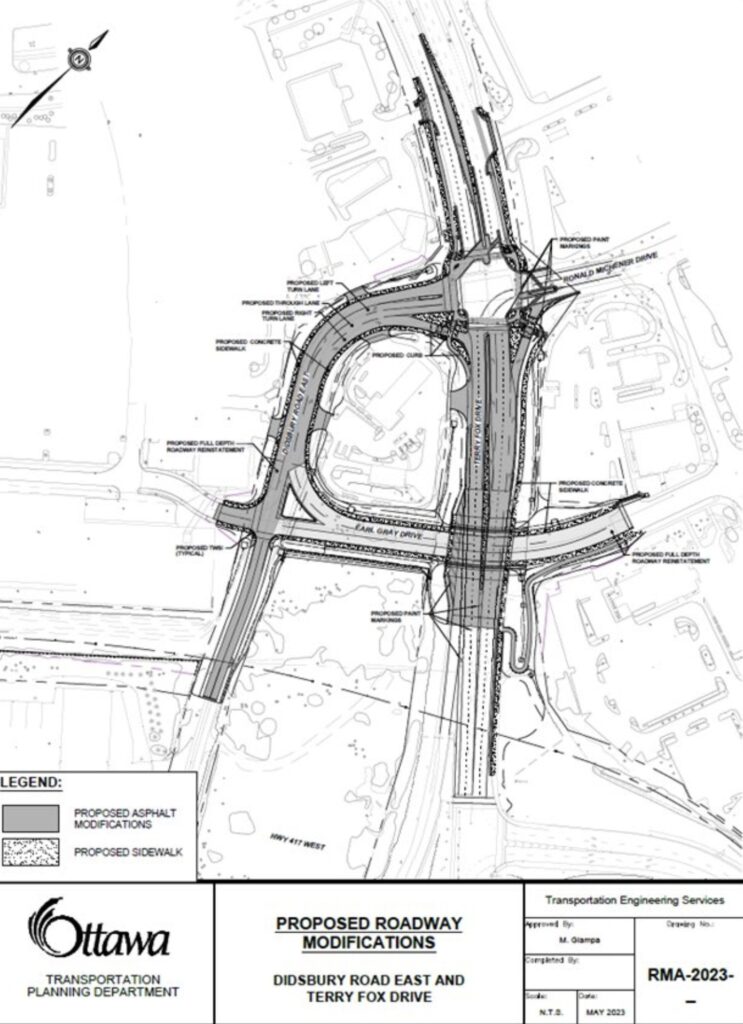
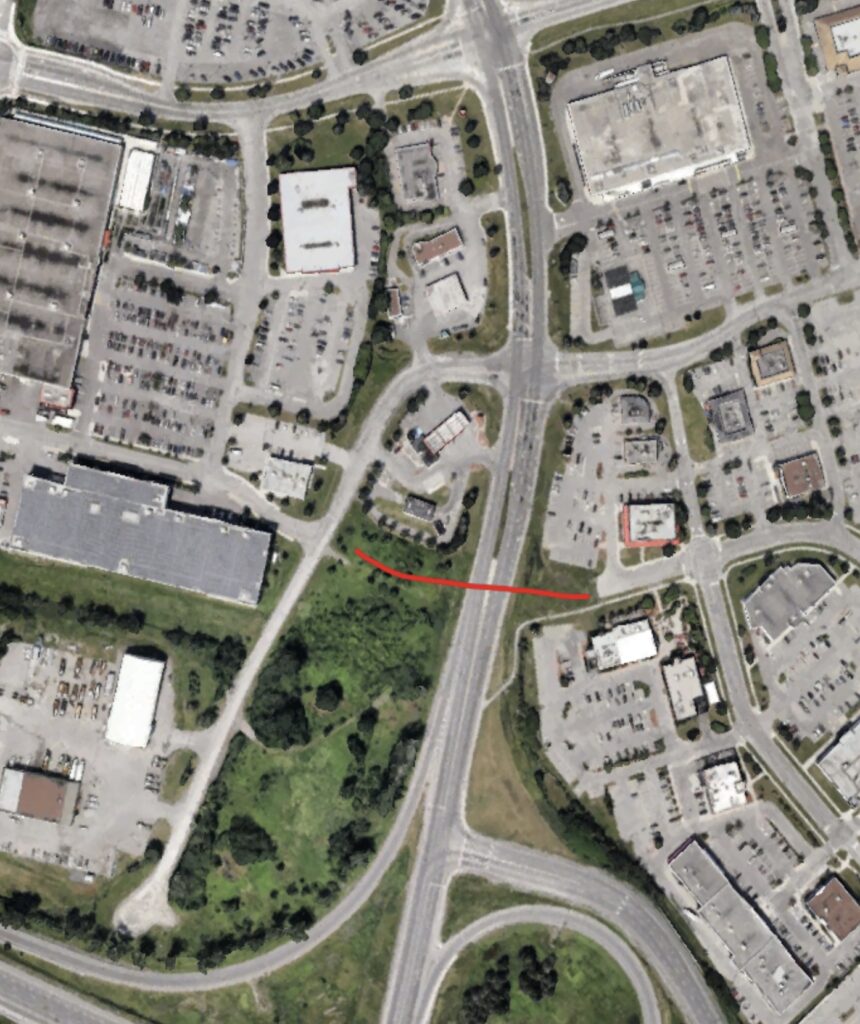
Unfortunately, there were no better resolution plans shared with the public to our knowledge, so the above photo is the best we have to work with.
The project can be broken into two distinct parts: the construction of the underpass and the modification of the intersection of Terry Fox Drive with Roland Michener Drive/Didsbury Road. When the project was first proposed, it only involved the underpass under Terry Fox Drive, but since this underpass will have an impact on the nearby Terry Fox intersection, it was also included in the scope of the underpass project for improvements.
From the underpass project’s original planning documents in previous transportation master plans, the main purpose for its construction was to improve car traffic circulation patterns in the area.
Budget
The total cost allocated for the project appears to be $22.834M. This is an increase from the original estimate of $3.5M in 2008 and $4.8M in 2013. The funding for this project is 95% from development charges and 5% from tax revenues.
Lack of Public Consultation
While the planned Didsbury Rd and Terry Fox Dr improvement project follows the Council approved Road Modification Approval process, which includes consultation by way of a public notice, we believe this to be unacceptable for a project of this scope and cost. Without design details, project justification, or impact to the community, it is difficult to understand what is being built with public funds.
We believe that it is extremely important to hold public consultations and open houses for large-cost projects for several reasons. Firstly, public consultation fosters transparency and accountability, ensuring that decisions regarding significant expenditures are made with the input and scrutiny of the affected communities. Without public input, there’s a risk of overlooking important perspectives, leading to decisions that may not reflect the diverse needs and interests of the community. Secondly, public consultation enhances trust and legitimacy in the decision-making process. By engaging the public, stakeholders have the opportunity to voice concerns, offer insights, and contribute to more informed and well-rounded decisions.
Our View
As we researched more into this project, we were left with more questions than answers. The main unanswered questions we feel need to be better addressed by the city are:
- Is a project that was designed and approved in 1995 justified being implemented in 2024?
- Has this project undergone the same scrutiny that new projects get today?
- What concrete benefits will this underpass project provide and what is the evidence supporting it?
Analysis
The underpass project’s original description promises to improve traffic circulation patterns in the area and more recently, in correspondence with city staff, we were also told that the underpass would have some bus rapid transit benefits. Unfortunately we were unable to find any evidence which would back up these claims. It appears as though most routes use Kanata Ave. to access the Terry Fox park and ride.
We wanted to get an idea of the current traffic conditions, however the data available on the city’s open data website does not segment data into distinct turning motions. Without this breakdown it is unclear how the current intersection – where the main benefit appears to ease left-turning westbound traffic – would benefit from the underpass construction. Without official numbers, we gathered some data ourselves.
We focused on the section which appears to be the major focus of this roadway modification – the two westbound left turn lanes out of Kanata Centrum shopping mall. We counted the cars at a time when it is likely to be busiest – on a weekend around lunchtime on a sunny warm day.
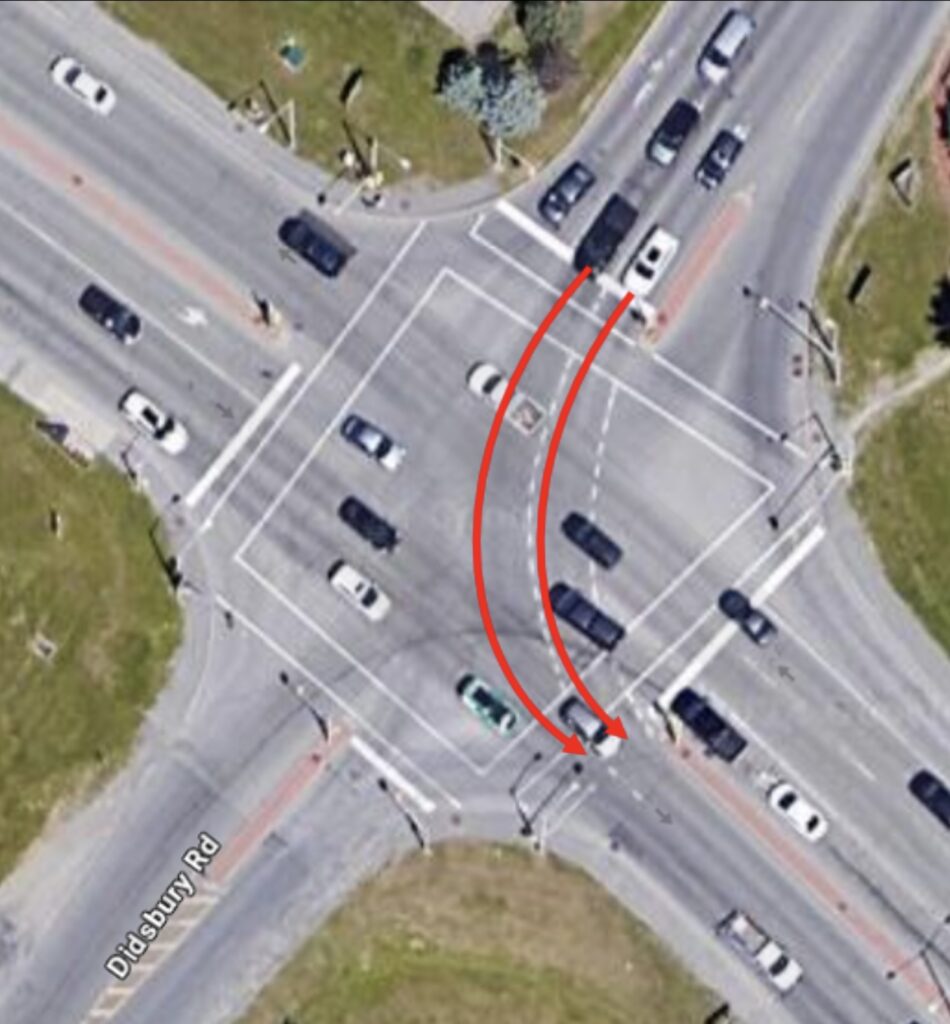
The car traffic was monitored at this intersection for one hour, and on only one occasion did a vehicle need to wait for a second light cycle. The reason in this particular instance was that there were two people on their phones in the queue who held back the traffic when the light turned green. The average red light wait time was 1 minute 30 seconds, with the longest being 1 minute 53 seconds. See table 1 below for detailed results. The data we collected on the westbound left-hand turn suggests that the queue time is minimal and is usually cleared with a single light cycle so it is difficult for us to see what major benefits an underpass would provide.
While we support the protected intersection at Didsbury and Terry Fox (with reservations: see below), the benefits of the underpass appear more difficult to justify for such a large cost. As recently as 2010, the underpass project was estimated to cost $3.5M. Referencing the Scott street protected intersections project, a protected intersection is estimated to cost about $3M so the underpass portion has since increased in cost to almost $20M.
The modification of the protected intersection at Didsbury and Terry Fox will adhere to the Protected Intersection Design Guide published by the City of Ottawa. Given the proximity to Kanata Centrum Shopping Centre, the Terry Fox park and ride, and a future LRT extension as part of Stage 3, the modification of this intersection is well merited and we applaud the decision to increase the safety of our streets. We strongly oppose, however, the inclusion of a slip lane in the protected intersection design as this prioritizes car traffic over the safety of people walking and cycling. Further, travelling southbound on Terry Fox it appears as though the cycling lane floats in the middle of the roadway while cars merge across it to join the highway. This design is not safe, and will limit the facility being used to its full potential. Cycling infrastructure should be built to accommodate all ages and abilities.
Modern Scrutiny
In the last 30 years, traffic planning has undergone a significant transformation, shifting away from a predominantly car-centric approach towards a more multi-modal perspective. This evolution reflects a growing recognition of the problems of car-focused transportation systems in addressing urban challenges such as congestion, air pollution, inequitable access to mobility, and the ever-rising cost of maintaining expensive car-centric infrastructure.
We do not see any of these ideals reflected in the underpass design. There are no cycling facilities planned and the proposal of a double slip-lane at Didsbury and Earl Grey is wholly unacceptable and precludes safe active transport in the area. Single-lane slip lanes are extremely dangerous for people not using cars, but two-lane ones are yet more dangerous.
If one were to analyze the merits of the new underpass proposal under the City’s own Transportation Master Plan, the current design would be challenged on many fronts:
- Policy 2-3: Design Streets for All People Including Equity-Deserving Individuals: The clear lack of any active transportation facilities as well as the introduction of two slip lanes for cars demonstrates that this policy is not being met.
- Policy 5.1: Adhere to best practices for network development: The network principles described in this policy focus on reducing automobile dependence by making walking and cycling more attractive than driving for short trips. This project does nothing to address this policy. It only serves to make it more convenient to drive.
- Policy 5.2: Prioritize modes of travel that are space efficient: The city’s own data states that pedestrians and cyclists are more space efficient than cars. These methods of transportation should be accommodated with safety being the main priority.
- Policy 5-7 Apply a Long-Term Affordability Lens to Transportation Investments: The construction of an underpass will require significant maintenance costs throughout its lifetime.
- Policy 6.4: Make it Easier to Cross the Road: The addition of slip lanes in both the protected intersection and the underpass design (two adjacent slip lanes in one area) makes it more difficult and more dangerous to cross the road. This is reaffirmed by the City of Ottawa’s own Pedestrian Intersection Safety Countermeasures Handbook from 2010 which states: “right turn slip lane designs are viewed as a negative from a pedestrian due to the emphasis on convenient and fast turning movements for vehicles.” Slip lanes prioritize motorist convenience over the well-being of anyone outside of a car, which we oppose in the strongest possible terms.
- Policy 7-2: Improve and Expand the Cycling Network: The absence of active transportation lanes in the underpass design goes directly against this policy. If this underpass is warranted by vehicular traffic, then surely it also merits active transportation facilities as well.
Conclusion
As quoted from the Transportation Master Plan: “As noted in Policy 9.2, projects to add road capacity will still be required in certain contexts – for example, to complete the transportation network in new or growing areas of the city.” Without the data to back up the requirement for this new underpass, or a meaningful consultation with the public about this project, it is hard for us to see the justification for this new project – especially at such a high cost. While improving our infrastructure is usually a good thing, we should be basing it on current and forecast benefits for the city and its citizens; not simply because it was previously planned.
We urge the city to hold a public consultation for this project before it moves forward to better inform the public about the project’s benefits and ensure that this project meets all the diverse needs and interests of the community.
Supplementary Information
Mention of the underpass project (Internal Order 904995) and its timeline in city documents are highlighted below:

- 2009 Planning Committee
- The Transportation Master Plan identifies the underpass as a Phase 2 (2016-2022) project and the Terry Fox Drive widening as a Phase 3 (2023-2031) project. The draft 2010 Budget forecast allocates $3.5 million to the underpass project in the 2013-2019 period.
- 2010 Transit Committee report regarding the west transitway connection planning study
- The Extension of Earl Grey Drive:
… Earl Grey Drive will be extended under Terry Fox and back to the Centrum development, allowing for a better level of service to the area and improving traffic circulation patterns.
- The Extension of Earl Grey Drive:
- 2013 Transportation Master Plan and 2013 Draft Transportation Budget Book
- The Earl Grey/Centrum Underpass project is a grade separated crossing underneath Terry Fox Drive to provide a direct connection between commercial developments on the east and west side of Terry Fox Drive. It includes the extension of Earl Grey Drive (approximately 175 m) from Earl Grey/Rolland Michener intersection to Didsbury Road west of Terry Fox Drive. This project will improve traffic circulation patterns in the area. Design and construction of this project is being coordinated with the West Transitway underpass (at Terry Fox Drive) to minimize disruption to traffic and the community. Funding this year is required for detailed design and funds have been identified for construction in 2014.
- Total estimated cost: $4.8 M
- Allocation of funds in 2013 of $1.5M
- Delayed in 2016 due to budgetary constraints
- A council meeting in June 2023 for approval to expropriate lands for the project
- 2024 Draft Budget
- Total estimated cost: $22.834M
- Total estimated cost: $3.5M
————————————
Table 1: Traffic counts of westbound-to-southbound traffic exiting Kanata Centrum shopping centre onto Terry Fox Drive on Saturday September 16, 2023. Weather: sunny, 22C.
| Light number | Time of day (approx.) | Number of cars through intersection | Number of cars needing to wait for a second red light | Red light length (approx.) | Green light length (approx.) | Comment |
| 1 | 1:35pm | 16 | 0 | (not measured) | (not measured) | |
| 2 | 12 | 0 | – | – | ||
| 3 | 9 | 0 | – | – | ||
| 4 | 16 | 0 | – | – | ||
| 5 | 1:43pm | 12 | 0 | – | – | |
| 6 | 14 | 0 | – | – | ||
| 7 | 13 | 0 | – | – | ||
| 8 | 1:49pm | 17 | 0 | – | – | |
| 9 | 7 | 0 | – | – | ||
| 10 | 1:53pm | 18 | 0 | 1m 53s | 25s | |
| 11 | 13 | 0 | 1m 27s | 24s | ||
| 12 | 8 | 0 | 1m 15s | 18s | ||
| 13 | 1:59pm | 15 | 0 | 1m 42s | 25s | |
| 14 | 17 | 0 | 1m 22s | 25s | ||
| 15 | 14 | 3 | 1m 35s | 25s | Two people on their phones not paying attention did not allow all cars to get through the red light. | |
| 16 | 20 | 0 | 1m 30s | 25s | ||
| 17 | 15 | 0 | 1m 25s | 25s | ||
| 18 | 16 | 0 | 1m 30s | 25s | ||
| 19 | 2:10pm | 12 | 0 | 1m 25s | 23s | |
| 20 | 8 | 0 | 1m 30s | 25s | ||
| 21 | 15 | 0 | – | – | ||
| 22 | 12 | 0 | 1m 15s | 20s | ||
| 23 | 14 | 0 | 1m 52s | 25s | ||
| 24 | 2:19pm | 9 | 0 | – | – | |
| 25 | 11 | 0 | – | – | ||
| 26 | 2:24pm | 11 | 0 | – | – | |
| 27 | 9 | 0 | – | – | ||
| 28 | 2:27pm | 21 | 0 | – | – | |
| 29 | 12 | 0 | – | – | ||
| 30 | 2:31pm | 10 | 0 | – | – | |
| 31 | 9 | 0 | – | – | ||
| 32 | 2:35pm | 14 | 0 | – | – | |
| 33 | 2:37pm | 16 | 0 | – | – |
Steven Bielby is a member of Bike Ottawa’s Advocacy Working Group

